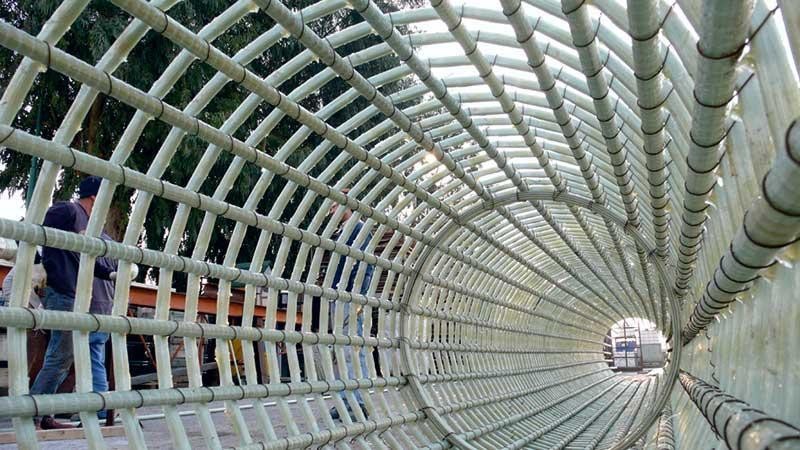- November 6, 2024
- Posted by: wellcoindustries
- Category: Rebar
Introduction to GFRP Fiberglass Rebar
In the ever-evolving construction industry, the push toward advanced materials has introduced GFRP fiberglass rebar as a promising alternative to traditional steel reinforcement. Glass Fiber Reinforced Polymer (GFRP) rebar offers a lightweight, corrosion-resistant, and non-conductive reinforcement option that is transforming infrastructure and building design. As concrete reinforcement needs become more complex, GFRP fiberglass rebar stands out for its ability to meet these needs, especially in challenging environments. This article will explore the benefits, applications, and future potential of GFRP fiberglass rebar, shedding light on why it is increasingly regarded as the future of construction reinforcement.

What is GFRP Fiberglass Rebar?
GFRP fiberglass rebar is a composite material made from high-strength glass fibers and polymer resin. This combination results in a durable, non-corrosive reinforcement bar that offers numerous advantages over traditional steel rebar. With a high strength-to-weight ratio and inherent resistance to corrosion, GFRP fiberglass rebar is ideal for environments where steel would quickly degrade or rust. These benefits have led to increased interest from the construction industry, especially in projects that demand longevity and resilience.
Comparison with Traditional Steel Rebar
Steel rebar has been the standard for reinforcing concrete, primarily due to its tensile strength and availability. However, steel is prone to corrosion, particularly in environments exposed to water, chemicals, or salt. GFRP fiberglass rebar, in contrast, does not corrode, making it an attractive choice for projects like bridges, marine structures, and high-salinity environments. Additionally, GFRP rebar is approximately one-quarter the weight of steel, facilitating easier transport and installation.
Core Materials and Properties
GFRP is primarily composed of glass fibers that are bound together with a polymer resin, giving it a combination of rigidity and flexibility. This unique composition grants it strength while also enabling some flexibility, a crucial property for structures that may experience dynamic loads, such as bridges and tunnels.
How GFRP Fiberglass Rebar is Made
The manufacturing process for GFRP fiberglass rebar differs significantly from steel rebar. Glass fibers are arranged in a continuous strand and then impregnated with resin to bind the material. This resin is cured to create a hardened rebar that is lightweight yet incredibly strong. Unlike steel rebar, which is forged and welded, GFRP is pultruded, meaning it is pulled through a mold to create a solid, consistent cross-section. This process ensures that GFRP rebar maintains uniform strength and resistance to environmental stressors.
Key Properties of GFRP Fiberglass Rebar
Strength and Durability
GFRP fiberglass rebar is known for its high tensile strength, rivaling that of steel rebar. Additionally, because it does not corrode, it is especially durable in harsh environments where moisture or chemicals would weaken steel.
Corrosion Resistance
One of the most significant advantages of GFRP rebar is its corrosion resistance. Unlike steel, GFRP does not rust, meaning it remains stable and maintains its strength even when embedded in wet or high-salinity conditions.
Non-Conductive Properties
In addition to its corrosion resistance, GFRP rebar is non-conductive, making it suitable for projects near electrical equipment or in structures that must limit electromagnetic interference.
Lightweight and Ease of Handling
Weighing just a fraction of steel rebar, GFRP is easier to transport, handle, and install. Its lightness reduces the labor and equipment costs associated with installation, further enhancing its appeal in large-scale projects.
Advantages of GFRP Fiberglass Rebar Over Steel
The benefits of GFRP fiberglass rebar extend far beyond corrosion resistance. Its lightweight nature allows for faster and safer installations, often with reduced labor and machinery. Additionally, GFRP’s non-conductive and non-magnetic properties make it ideal for sensitive applications such as MRI facilities, research centers, and high-frequency environments.
Applications of GFRP Fiberglass Rebar in Construction
GFRP fiberglass rebar has found applications across numerous sectors of the construction industry:
- Infrastructure and Bridge Construction: Ideal for bridge decks and supports, where long-term durability is critical.
- Marine Structures: Highly resistant to saltwater, GFRP rebar is often used in piers, docks, and seawalls.
- Roadways and Tunnels: Used in tunnel linings and road barriers to enhance durability in challenging conditions.
- Foundations and Concrete Slabs: Provides reinforced support while remaining stable under various environmental stresses.
Environmental Impact of GFRP Rebar
With its high durability and reduced need for maintenance, GFRP fiberglass rebar has a lower overall environmental footprint compared to steel. It minimizes the need for repairs and replacements, reducing waste and energy consumption over time. Its compatibility with green building standards further supports sustainable construction practices.
Cost-Effectiveness of GFRP Fiberglass Rebar
While the initial cost of GFRP may be higher than steel, its long-term cost benefits are significant. Reduced maintenance and repair needs, combined with a longer lifespan, often make GFRP a more cost-effective choice in the long run.
Challenges and Limitations of GFRP Fiberglass Rebar
Despite its advantages, GFRP fiberglass rebar has some limitations. It may not be suitable for all high-stress applications, and it requires special handling and storage procedures due to its unique properties. Additionally, because it is relatively new to the market, GFRP rebar can be more costly than traditional steel, especially in regions where it is not widely available.
How to Install GFRP Fiberglass Rebar
Installation of GFRP rebar is generally straightforward but may differ slightly from steel. Specialized cutting tools and fasteners are recommended due to GFRP’s unique material properties. Proper installation techniques help ensure the rebar’s longevity and effectiveness.
Regulations and Standards for GFRP Rebar
Compliance with building codes and standards is essential. As GFRP rebar gains popularity, industry organizations are developing standardized guidelines for its use, ensuring quality and safety across projects.
Conclusion
GFRP fiberglass rebar represents a transformative shift in construction, offering unparalleled benefits for durability, sustainability, and performance. From bridges and tunnels to marine structures, GFRP is reshaping the possibilities of concrete reinforcement. As innovations continue and standards evolve, GFRP fiberglass rebar is poised to become a mainstay in modern construction, paving the way for a more resilient and sustainable future.
